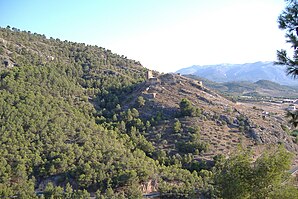Pliego (Murcia)
| Pliego municipality | ||
|---|---|---|
 Pliego - castle ruins
|
||
| coat of arms | Map of Spain | |

|
|
|
| Basic data | ||
| Autonomous Community : |
|
|
| Comarca : | Comarca del Río Mula | |
| Coordinates | 37 ° 59 ′ N , 1 ° 30 ′ W | |
| Height : | 385 msnm | |
| Area : | 29.43 km² | |
| Residents : | 3,847 (Jan 1, 2019) | |
| Population density : | 130.72 inhabitants / km² | |
| Postal code : | 30176 | |
| Municipality number ( INE ): | 30032 | |
| administration | ||
| Website : | Pliego | |
Pliego is a southern Spanish city and a municipality ( municipio ) with a total of 3,847 inhabitants (as of January 1 2019) in the center of the province of Murcia in the same autonomous region of Murcia .
location
The place Pliego is about 45 km (driving distance) west of the city of Murcia at an altitude of about 370 to 400 m above sea level. d. The climate in winter is temperate, in summer it is warm to hot; the low amounts of precipitation (approx. 335 mm / year) fall - with the exception of the almost rainless summer months - distributed over the whole year.
Population development
| year | 1857 | 1900 | 1950 | 2000 | 2016 |
| Residents | 2,579 | 2,745 | 3,238 | 3,409 | 3,933 |
The continuous increase in population is mainly due to the immigration of people from the surrounding villages.
economy
Pliego is located in the west of the agriculturally used core zone of the province of Murcia - in the past, grain, grapevines as well as olive and fruit trees of all kinds were planted for self-sufficiency ; Vegetables came from the house gardens. Today mainly peaches, apricots and citrus fruits are harvested. Small traders, craftsmen and service companies of all kinds have settled in the village. There are also several holiday homes (casas rurales) .
history
Small Bronze Age finds were made on a limestone plateau ; the associated settlement was named La Almoloya . Roman and Visigoth finds are missing. In the years after 711 the area was overrun by the Moors . Already in 10./11. A castle was built in the 19th century; At the end of the 12th century, the Berbers founded a fortress (hisn) and a surrounding village on another hill . After the end of the Caliphate of Córdoba that arose Taifa Kingdom Murcia, which after the reconquest ( reconquista ) of the region by Castilian troops under Alfonso X in 1243 in a Christian kingdom was converted, which, however closely with the Crown of Castile was intertwined . After an uprising in the years 1264-1266, the Berber settlement was destroyed; the entire region was given into the hands of the Order of Santiago . A new place was created in the valley. At the beginning of the 16th century, many Moors ( moriscos ) left the country; others stayed and were not until the beginning of the 17th century by decrees of Philip III. or his First Minister, the Duke of Lerma , expelled from the country, which had negative demographic and economic consequences for the region.
Attractions
- Only ruins remain of the two medieval castles Castillo de las Paleras and Castillo de Pliego .
- The Iglesia de Santiago is a building from the middle of the 18th century; it consists of (partially plastered) quarry stone masonry. The nave has side chapels and a dome resting on a drum .
- The Casa de la Tercia was a granary (Pósito) Order of Santiago. The current building dates from 1802 and shows the Jacob's cross above the portal.
- The Museo de la Almazara Santiaguista deals with the production of oil.
- Today the town hall (ayuntamiento) is housed in a noble building from the 18th century (Casa Grande) .
- The three-aisled Ermita de la Virgen de los Remedios stands on a rock spur on the outskirts; it dates from the 18th century and impresses with a curved bell gable (espadaña) and an outside balcony.
Web links
Individual evidence
- ↑ Cifras oficiales de población resultantes de la revisión del Padrón municipal a 1 de enero . Population statistics from the Instituto Nacional de Estadística (population update).
- ↑ Pliego - Map with altitude information
- ↑ Pliego - climate tables
- ↑ Pliego - population development
- ↑ Pliego - Economy etc.
- ↑ Pliego History
- ↑ Pliego - Castillo de las Paleras
- ↑ Pliego - Castillo
- ↑ Pliego - Iglesia de Santiago Apóstol
- ↑ Pliego - Iglesia de Santiago Apóstol
- ↑ Pliego - Granary
- ↑ Pliego Museum
- ↑ Pliego - Casa Grande
- ↑ Pliego - Ermita

